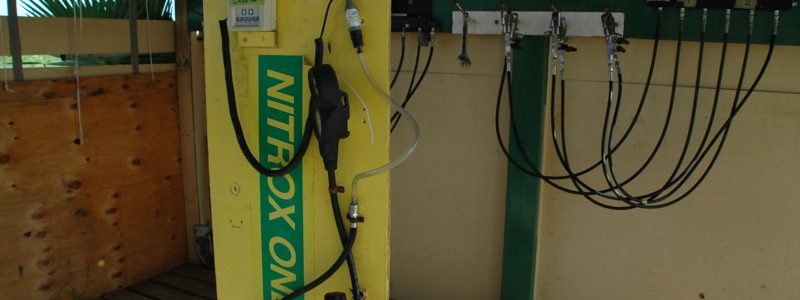As a Nitrox Diver, you have to understand Oxygen Toxicity
At this point, you have to be asking, why didn’t I hear about the adverse effects of oxygen in my Open Water or Beginner Scuba Diver certification class? Good question; and some agencies are changing that and making it a part of the beginner lesson plan. Continued from: Part 1 Oxygen Management
However, some agencies are not teaching it because they feel the depth at which oxygen toxicity (when diving on air) becomes an issue is way too deep for a new diver. And, if a new diver is that deep, they have more to be concerned about than oxygen toxicity. A fair argument since most new divers are using air (21% oxygen / 79% nitrogen) and the toxic depths of air are generally below 200 feet. However, this theory is flawed when dealing with the buddy system or diving off a boat with divers who may be using enriched air or Nitrox blends in excess of 21% oxygen. In this scenario, even the non-Nitrox diving buddy needs to be aware of the risks surrounding him in the water. A diver using a common blend of 32% Nitrox (32% Oxygen / 68% Nitrogen) can have a Tox Hit within the recreational limits of 130 feet. Now oxygen management is a concern for everyone diving with that buddy.
Enriched Air Versus Nitrox
We’ve been throwing a lot of terms at you. Nitrox, air, enriched air, etc. Air is simply what you are breathing while surfing the web reading this article. It is comprised, simply put, of 21% Oxygen and 79% Nitrogen. Nitrox is a “slang term” for any nitrogen/oxygen blend. This means, technically, air is a Nitrox blend. However, Nitrox has become a common replacement for enriched air. Enriched air is any blend of nitrogen and oxygen exceeding 21% oxygen in the mix. That means a Nitrox blend of 23% oxygen and 77% nitrogen is Nitrox.
Hypoxia and Hyperoxia and how it relates to Scuba Diving
The human body needs a specific amount of oxygen to survive. It can’t be too little and it can’t be too much. Hypoxia is a condition in which tissues are deprived of an adequate supply of oxygen. On land, this usually occurs in folks with normal physiology when the oxygen content in a breathing mix drops below 16%. People are considered hypoxic when this happens.
Hyperoxia is a condition caused by an excess of oxygen in tissues and organs. On land, this usually occurs in people with normal physiology when the oxygen content in a breathing mix is above 160% or have been breathing high O2 mixes (like pure O2) for an extended period of time. It is near impossible for someone to become hyperoxic on land. Hyperoxia requires pressure to get the breathing mix to a comparable 160%. Of course, the scuba environment is the perfect place to experience pressure.
In your first pool session, you felt the effects of pressure on your body from water, probably in your ears. This pressure has a physiological effect that you don’t necessarily feel. It is compounding the effects of oxygen. In fact, at 33 feet (salt water), the effects of oxygen are doubled. As mentioned above, air is 21% oxygen. However, physiologically at 33 feet, it has the same effect on your body as 42% oxygen. This effect is compounded the deeper your go. At 99 feet, air (21%) is four times more effective and comparable to 84% oxygen (almost pure O2). Now you can see, with depth, how hyperoxia can occur while scuba diving. For “air” divers, hyperoxia is less of a concern compared to narcosis or decompression sickness. However, for “enriched air” divers, their high O2 blends can create high partial pressures which can easily lead to hyperoxia. Imagine someone with an enriched air blend with 40% oxygen and 60% nitrogen. At 100 feet (salt water), that O2 content is equivalent to 160%. This diver is well within recreational limits and breathing a recreational “Nitrox” blend. You, as his buddy may, not understanding the dangers, lead him to depths below 100 feet. Now you understand the importance of oxygen management.
Continued: What is Partial Pressure?

